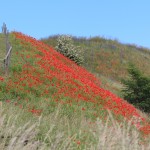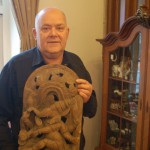 Where do you take someone who has never been to southern Sweden
Where do you take someone who has never been to southern Sweden
before and wants to get away from it all? My recommendation is to
visit a stone in a field in Dag Hammarskjöld´s Backåkra
and enjoy some calming views of the Österlen coast.
This is not just any old stone. Engraved into the surface is the
word PAX. In case you did not have the benefit of studying Latin at
school, PAX means PEACE. Words have power and I believe this place
imparts a sense of peace to the visitor; a place to sit and ponder
on the state of the world or just escape the bustle for a moment.
Bring your worries or the world’s troubles to this place, release
them and leave with a lesser burden or with renewed hope for the
future.
A friend and I came here from England while visiting Malmö in Sweden
for a long weekend in wintertime. It was not the warmest time of
year to visit Sweden and the snow had fallen covering the rolling
landscape of the county of Skåne in a white cloak. I decided to
brave the weather and take my friend to this stone that I had
visited once before in the summer. In winter, it would be an
entirely different experience.
Skåne is not like more northerly parts of Sweden where there are
pine forests as far as the eye can see. The Skåne countryside is an open agricultural landscape
of rolling fields with some woodlands.
East of Ystad stretches the area known as Österlen that is a popular
place for artists to practise their crafts. Going eastward from Ystad, the main road to Simrishamn follows a stretch of coastline with sandy beaches popular for bathing in the summer.
We turn off to the right after Nybostrand to take the eastern coast
road. The route takes us slightly inland as the landscape becomes
more undulating with a ridge of hills rising up at the coast from an
otherwise flat landscape.
Just after passing Backagården, I know we are near. I have stopped
at this popular tourist spot on a number of occasions. There is a
cafe inside the house but you can also take your refreshments out
into the large conservatory to enjoy the sun and indoor plants. The
shop inside sells arts, crafts and antiques.
I see the turn towards Löderups Strandbad and Kåseberga but keep
straight on until I see the signs to Backåkra. It is here that the
renowned Swedish diplomat Dag Hammarskjöld bought a secluded farm in
1957. Hammarskjöld was elected as Secretary-General to the United
Nations in 1953 at the young age of 47. He did not live long to
enjoy his new summer residence. In September 1961 while on a UN
mission in the Congo, his plane crashed killing him and all on
board. His death is clouded in mystery and is still under
investigation by the UN. Though officially an accident, some eye
witnesses say his plane was shot down as it came in to land at
Ndola. Whatever happened, a great statesman was silenced in his
prime.
After his death, the estate at Backåkra was bequeathed to the
Swedish Tourist Association (Svenska Turistföreningen) as a place of
sanctuary and cultural activities. The 30 hectares of land around
the farm is a nature reserve that is open to the public at any time
of year. The farm building itself, which contains artefacts
belonging to Dag Hammarskjöld, is currently closed to visitors while
awaiting renovation.
We follow the signs to Dag Hammarskjöld’s Backåkra taking us up a
winding narrow track full of snow and I am not sure if we will be
able to reach the top. Thankfully we manage the slippery bends and
find we are the only car in the car park at this time of year.
To reach the inscribed stone, we follow the signs to the meditation
place and wander across a large field. The stone is in the centre of
a circle with a low perimeter wall. The view of the coast is
unspoilt from here and we quietly take in the peaceful scene,
enjoying the solitude. We are fortunate to see a purple sunset that
afternoon indicative of the special lighting that has made Österlen
an inspiring place for landscape artists.
Kids just love this place because they can run around freely on the
grassy slopes. While adults like to ponder and meditate here, kids
tend to go wild! Peace is not what everyone seeks or finds!
At the bottom of the large field, a gate leads to a path through the
forest to the sea and sandy beaches. A good place for the family to
regroup is at Löderups Strandbad, a nearby hotel and restaurant
complex just along the coast from Backåkra offering rooms
overlooking the sea. During the tourist season, the restaurant
serves an excellent buffet.
If you have an appetite to see more stones, just up the coast to the
west is the spectacular formation of Ales Stones in the shape of a
ship. The site of the stones is on high ground overlooking the
sea with panoramic views. Ales Stones are the largest ship formation in
Sweden attracting many thousands of visitors – Sweden’s answer to
Stonehenge!
There is something about the high ground of the coastal landscape
here in Österlen that imbues a feeling of peace, an unwinding of
stress and a heightened sense of being. Our ancestors who created
Ales Stones about 1400 years ago probably felt it too.

 You may not associate the climate of Sweden with winegrowing but in this northerly part of Europe in the county of Skåne, a number of vineyards have grown up since the turn of the millennium. The changing climate is working in favour of growing vines here but the climate is still far from ideal and makes winemaking a risky business. Nevertheless, with the right types of grapes and a lot of enthusiasm, wines of character with a distinct acidic taste can be made.
You may not associate the climate of Sweden with winegrowing but in this northerly part of Europe in the county of Skåne, a number of vineyards have grown up since the turn of the millennium. The changing climate is working in favour of growing vines here but the climate is still far from ideal and makes winemaking a risky business. Nevertheless, with the right types of grapes and a lot of enthusiasm, wines of character with a distinct acidic taste can be made.